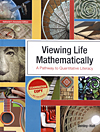- About MAA
- Membership
- MAA Publications
- Periodicals
- Blogs
- MAA Book Series
- MAA Press (an imprint of the AMS)
- MAA Notes
- MAA Reviews
- Mathematical Communication
- Information for Libraries
- Author Resources
- Advertise with MAA
- Meetings
- Competitions
- Programs
- Communities
- MAA Sections
- SIGMAA
- MAA Connect
- Students
- MAA Awards
- Awards Booklets
- Writing Awards
- Teaching Awards
- Service Awards
- Research Awards
- Lecture Awards
- Putnam Competition Individual and Team Winners
- D. E. Shaw Group AMC 8 Awards & Certificates
- Maryam Mirzakhani AMC 10 A Awards & Certificates
- Two Sigma AMC 10 B Awards & Certificates
- Jane Street AMC 12 A Awards & Certificates
- Akamai AMC 12 B Awards & Certificates
- High School Teachers
- News
You are here
Viewing Life Mathematically

Publisher:
Hawkes Learning Systems
Publication Date:
2015
Number of Pages:
875
Format:
Hardcover
ISBN:
9781935782056
Category:
Textbook
[Reviewed by , on ]
Hannah Robbins
02/27/2015
Viewing Life Mathematically is intended for a college general education math course for students who aren’t required to take statistics or calculus. Its goal is to provide these students with some of the benefits of mathematics, with the clear understanding that the teacher will inevitably face the age-old student question “When will I ever use this in real life?”
From a content perspective, I think this is an excellent book. Its topics range from basic practical skills (ratios, percentages, statistics, problem solving), to real world applications (sports statistics, personal finance, voting), and beyond (graph theory, math in the arts, number theory). These chapters seem relatively independent, so that once through the first chapter the instructor could choose which topics fit best into their course and timeline. The exposition is clear and uncomplicated without coming across as patronizing, and there are many good example and exercises. I particularly like how Chapter 1 isolates problem solving as a separate topic and devotes great care to helping students realize that this is an acquired skill. My one minor quibble here is that the authors place more emphasis on practicality than on fun (at least in earlier chapters).
From an organizational and design perspective, my review is more mixed. I like that each chapter begins with an outline of the topics and objectives ahead and ends with a concise summary of the definitions and formulas covered in each section. However, inside each chapter, I feel the formatting is unhelpful. Each example is indicated with a colored bar, and each “Skill Check” is enclosed in a box. I found that this tended to make my eye go from example to example. This meant I was skipping the explanations of general ideas between the examples — not what one wants students to do! I also would have like the standard introductory format of brief (and separate) overviews for students and instructors. In particular, I wanted to see a clear statement of what earlier material was needed for each chapter.
Overall, I wish I had been an editor instead of a reviewer for this book. With a few simple stylistic tweaks, this would be a great textbook for a general education math course.
Hannah Robbins teaches math at Roanoke College in Virginia. She was previously a post-doc at Wake Forest University where she taught a Math for Liberal Arts class much like the one for which this book was intended.
|
|
||||||||||||||||||||||||||||||||||||||||||||||||||||||||||||||||||||||||||||||||||||||||||||||||||||||||||||||||||||||||||||||||||||||||||||
- Log in to post comments




